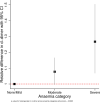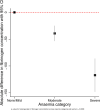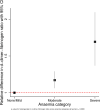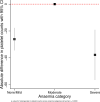Relationship between anaemia, coagulation parameters during pregnancy and postpartum haemorrhage at childbirth: a prospective cohort study
- PMID: 34607867
- PMCID: PMC8491293
- DOI: 10.1136/bmjopen-2021-050815
Relationship between anaemia, coagulation parameters during pregnancy and postpartum haemorrhage at childbirth: a prospective cohort study
Abstract
Objectives: To investigate the association between coagulation parameters and severity of anaemia (moderate anaemia: haemoglobin (Hb) 7-9.9 g/dL and severe anaemia: Hb <7 g/dL) during pregnancy and relate these to postpartum haemorrhage (PPH) at childbirth.
Design: A prospective cohort study of pregnant women recruited in the third trimester and followed-up after childbirth.
Setting: Ten hospitals across four states in India.
Participants: 1342 pregnant women.
Intervention: Not applicable.
Methods: Hb and coagulation parameters: fibrinogen, D-dimer, D-dimer/fibrinogen ratio, platelets and international normalised ratio (INR) were measured at baseline. Participants were followed-up to measure blood loss within 2 hours after childbirth and PPH was defined based on blood loss and clinical assessment. Associations between coagulation parameters, Hb, anaemia and PPH were examined using multivariable logistic regression models.
Outcomes measures: Adjusted OR with 95% CI.
Results: In women with severe anaemia during the third trimester, the D-dimer was 27% higher, mean fibrinogen 117 mg/dL lower, D-dimer/fibrinogen ratio 69% higher and INR 12% higher compared with women with no/mild anaemia. Mean platelets in severe anaemia was 37.8×109/L lower compared with women with moderate anaemia. Similar relationships with smaller effect sizes were identified for women with moderate anaemia compared with women with no/mild anaemia. Low Hb and high INR at third trimester of pregnancy independently increased the odds of PPH at childbirth, but the other coagulation parameters were not found to be significantly associated with PPH.
Conclusion: Altered blood coagulation profile in pregnant women with severe anaemia could be a risk factor for PPH and requires further evaluation.
Keywords: anaemia; epidemiology; obstetrics.
© Author(s) (or their employer(s)) 2021. Re-use permitted under CC BY. Published by BMJ.
Conflict of interest statement
Competing interests: None declared.
Figures






Similar articles
-
Folic acid supplementation and malaria susceptibility and severity among people taking antifolate antimalarial drugs in endemic areas.Cochrane Database Syst Rev. 2022 Feb 1;2(2022):CD014217. doi: 10.1002/14651858.CD014217. Cochrane Database Syst Rev. 2022. PMID: 36321557 Free PMC article.
-
Prenatal anaemia and risk of postpartum haemorrhage: a cohort analysis of data from the Predict-PPH study.BMC Public Health. 2024 Apr 12;24(1):1028. doi: 10.1186/s12889-024-18446-5. BMC Public Health. 2024. PMID: 38609913 Free PMC article.
-
Maternal anaemia and the risk of postpartum haemorrhage: a cohort analysis of data from the WOMAN-2 trial.Lancet Glob Health. 2023 Aug;11(8):e1249-e1259. doi: 10.1016/S2214-109X(23)00245-0. Epub 2023 Jun 27. Lancet Glob Health. 2023. PMID: 37390833 Free PMC article. Clinical Trial.
-
Active versus expectant management for women in the third stage of labour.Cochrane Database Syst Rev. 2019 Feb 13;2(2):CD007412. doi: 10.1002/14651858.CD007412.pub5. Cochrane Database Syst Rev. 2019. PMID: 30754073 Free PMC article.
-
Diagnosis and treatment of peripartum haemorrhage, consensus of the interdisciplinary working group by the modified ACCORD method.Ceska Gynekol. 2025;90(1):72-89. doi: 10.48095/cccg202572. Ceska Gynekol. 2025. PMID: 40117262 English.
Cited by
-
Laboratory-based inequity in thrombosis and hemostasis: review of the evidence.Res Pract Thromb Haemost. 2023 Mar 15;7(2):100117. doi: 10.1016/j.rpth.2023.100117. eCollection 2023 Feb. Res Pract Thromb Haemost. 2023. PMID: 37063772 Free PMC article. Review.
-
Prepartum Anemia and Risk of Postpartum Hemorrhage: A Meta-Analysis and Brief Review.Clin Appl Thromb Hemost. 2023 Jan-Dec;29:10760296231214536. doi: 10.1177/10760296231214536. Clin Appl Thromb Hemost. 2023. PMID: 37968861 Free PMC article. Review.
-
Predeposit Autologous Blood Donation in Rh(D)-Negative Pregnant Women: A Single-Center Study.AJP Rep. 2024 Aug 30;14(3):e208-e214. doi: 10.1055/a-2388-3298. eCollection 2024 Jul. AJP Rep. 2024. PMID: 39219734 Free PMC article.
-
Impact of Maternal Preoperative Hemoglobin Levels on Intraoperative Hemorrhage Risk in Placenta Accrete Spectrum Disorders: A Retrospective Cross-Sectional Study.Med Sci Monit. 2023 Aug 10;29:e940443. doi: 10.12659/MSM.940443. Med Sci Monit. 2023. PMID: 37559346 Free PMC article.
-
Tranexamic acid for the prevention of postpartum bleeding in women with anaemia: Statistical analysis plan for the WOMAN-2 trial: an international, randomised, placebo-controlled trial.Gates Open Res. 2023 Aug 3;7:69. doi: 10.12688/gatesopenres.14529.2. eCollection 2023. Gates Open Res. 2023. PMID: 37664793 Free PMC article.
References
-
- World Health Organisation . Nutritional anaemias: tools for effective prevention and control. Geneva: WHO, 2017.
-
- World Health Organisation . The global prevalence of anaemia in 2011. Geneva: WHO, 2015.
Publication types
MeSH terms
Grants and funding
LinkOut - more resources
Full Text Sources
Medical
